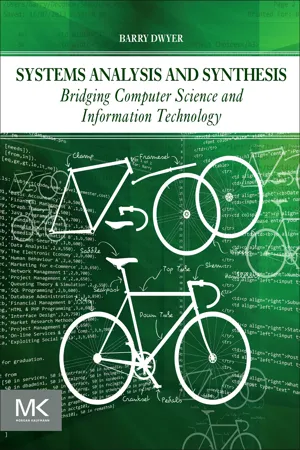
Systems Analysis and Synthesis
Bridging Computer Science and Information Technology
- 512 pages
- English
- ePUB (mobile friendly)
- Available on iOS & Android
About This Book
Systems Analysis and Synthesis: Bridging Computer Science and Information Technology presents several new graph-theoretical methods that relate system design to core computer science concepts, and enable correct systems to be synthesized from specifications. Based on material refined in the author's university courses, the book has immediate applicability for working system engineers or recent graduates who understand computer technology, but have the unfamiliar task of applying their knowledge to a real business problem.
Starting with a comparison of synthesis and analysis, the book explains the fundamental building blocks of systems-atoms and events-and takes a graph-theoretical approach to database design to encourage a well-designed schema. The author explains how database systems work-useful both when working with a commercial database management system and when hand-crafting data structures-and how events control the way data flows through a system. Later chapters deal with system dynamics and modelling, rule-based systems, user psychology, and project management, to round out readers' ability to understand and solve business problems.
- Bridges computer science theory with practical business problems to lead readers from requirements to a working system without error or backtracking
- Explains use-definition analysis to derive process graphs and avoid large-scale designs that don't quite work
- Demonstrates functional dependency graphs to allow databases to be designed without painful iteration
- Includes chapters on system dynamics and modeling, rule-based systems, user psychology, and project management
Frequently asked questions
Information
Table of contents
- Cover image
- Title page
- Table of Contents
- Copyright
- Foreword
- Preface
- Acknowledgments
- List of Figures
- List of Tables
- List of Algorithms
- Chapter 1. Systems, analysis, and synthesis
- Chapter 2. Mathematical background
- Chapter 3. Atoms
- Chapter 4. Data-structure analysis
- Chapter 5. Kernel specifications
- Chapter 6. Database technology
- Chapter 7. Processes
- Chapter 8. Interfaces
- Chapter 9. Rules
- Chapter 10. System dynamics
- Chapter 11. Project management
- Appendix A. Regular expressions and finite-state automata
- Appendix B. Normalisation
- Appendix C. Answers to the exercises
- Index